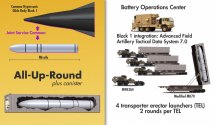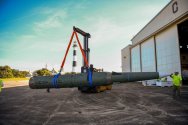Does this look like a "glider" to you?
View attachment 124275
View attachment 124276
I think it is just a two stage rocket with a biconic upper stage. I don't know why they call this a glider really.
And then they call the Kinzhal obsolete. When in the Kinzhal you also have a two stage solution where the first stage is the MiG-31K. A reusable platform which can fly at 25 km altitude at Mach 3.
Here is a US Pershing II from the Cold War.
View attachment 124277
It is another biconic. The shape of the MARV isn't that different. At least to me.
If the US wanted to emulate the Kinzhal they would need a launch platform of similar performance to the MiG-31K. The closest would be the F-15 with 20 km flight ceiling and Mach 2.5 top speed.
The concepts are confusing and everyone interprets them however they see fit.
Hypersonic missile technology is divided between boost-glide missiles powered by rocket engines and cruise missiles (HCM) that adopt an aspirated engine (scramjet).
This cruise missile technology is very complex. The Americans achieved successful flights with test vehicles with scramjet engines more than a decade ago, but to date they have not put any missile with this engine into operation. They must do so by 2025/27.
The Russians claim that they already have the Zircon that adopts a scramjet engine, but it should not yet have an anti-ship function.
The boost-glide system is nothing very sophisticated, being just a variation of the ballistic missile.
It uses the same propellants as this one, but at the end, instead of a ballistic reentry vehicle (BRV), it carries a hypersonic glide vehicle (HGV), which is nothing more than a maneuverable reentry vehicle (MaRV) with a greater rate of glide.
Every country that masters ballistic missile and orbital rocket technology will invariably develop HGV-type vehicles, sooner or later, depending on its priorities.
We currently have information that there are two of these already in operation, the Chinese DF-ZF which is mounted on the DF-17 with 2500 km of range and the Russian Avangard, which can be mounted on some Russian ICBMs (SS-19, SS-18 and Sarmat).
The Americans are developing at least 2 HGV vehicles, the cone-shaped C-HGB for the Dark Eagle/CPS missiles and the wedge-shaped HGV for the air-launched AGM-183(last I saw the USAF wanted cancel).
Hypersonics fly low and can therefore escape radars:
It is true compared to a ballistic missile, but it is incorrect compared to a subsonic cruise missile. And the height at which it flies is still at least 1000 times greater than the height at which a subsonic cruise ship flies.
The hypersonic missile maneuvers to evade defenses:
Again, compared to a ballistic missile that in theory does not maneuver, it is true, but it is inaccurate compared to a subsonic cruise missile that maneuvers much more and is even more inaccurate if we consider how difficult it is for a high-speed missile to maneuver. If you do this, it is to refine your “aim” and not to “escape” defenses.
Whether this helps to penetrate a defensive system compared to a ballistic missile whose BRV (ballistic reentry vehicle) has a more predictable trajectory is only a consequence.
The hypersonic missile is the fastest:
In general, a ballistic missile is faster because it doesn't have to trade speed for range, which is what a boost-glide does.
A hypersonic missile cannot be detected because it is encased in a plasma that absorbs enemy radar emissions:
It's not true because it flies at high altitude and in that case it wouldn't produce plasma through drag. Most likely, the plasma is produced in the terminal phase, when it plunges and is decelerated strongly at low altitude. In this case, the defense radar may not detect it but then it would be blind since if it adopts an active radar seeker, the plasma that surrounds it would not allow the RF to be emitted beyond the plasma layer formed in the radome.
It is worth noting that a missile seeker operates in the X or K bands, which are the most easily absorbed by plasma. The ship may have radars operating in different bands (C, S, L) that are less prone to being absorbed. In this case, even if the plasma formed in the dive protects the missile from detection by any ship's radar or IADS, it could still be intercepted at an altitude where the plasma has not yet formed. That is, above about 5 thousand meters. The missile would not be able to do so since its targets are at sea level or close to it. If the missile's radar does not work due to the formation of plasma, the missile would necessarily have to decelerate when in the terminal phase to a speed at which drag does not produce plasma and this is below Mach 5. By doing this the argument is lost. that hypersonic speed would make it better able to penetrate dense defenses.
Just out of curiosity, the MaRV of the Pershing II from the 80s compared to the C-HGB of the US Army and US Navy missiles that will enter into operation by 2023, the basic difference between the MaRV of the Pershing II and the C-HGB is that the first would glide for 10% of its trajectory and the last will glide for 70%.
An interesting article from the 80s:



